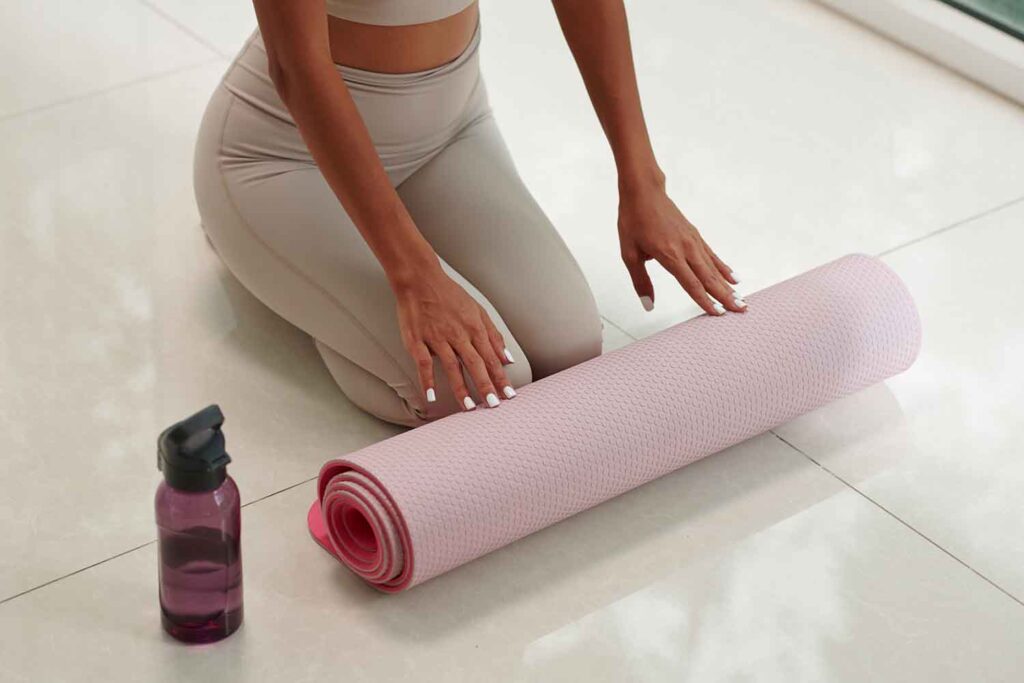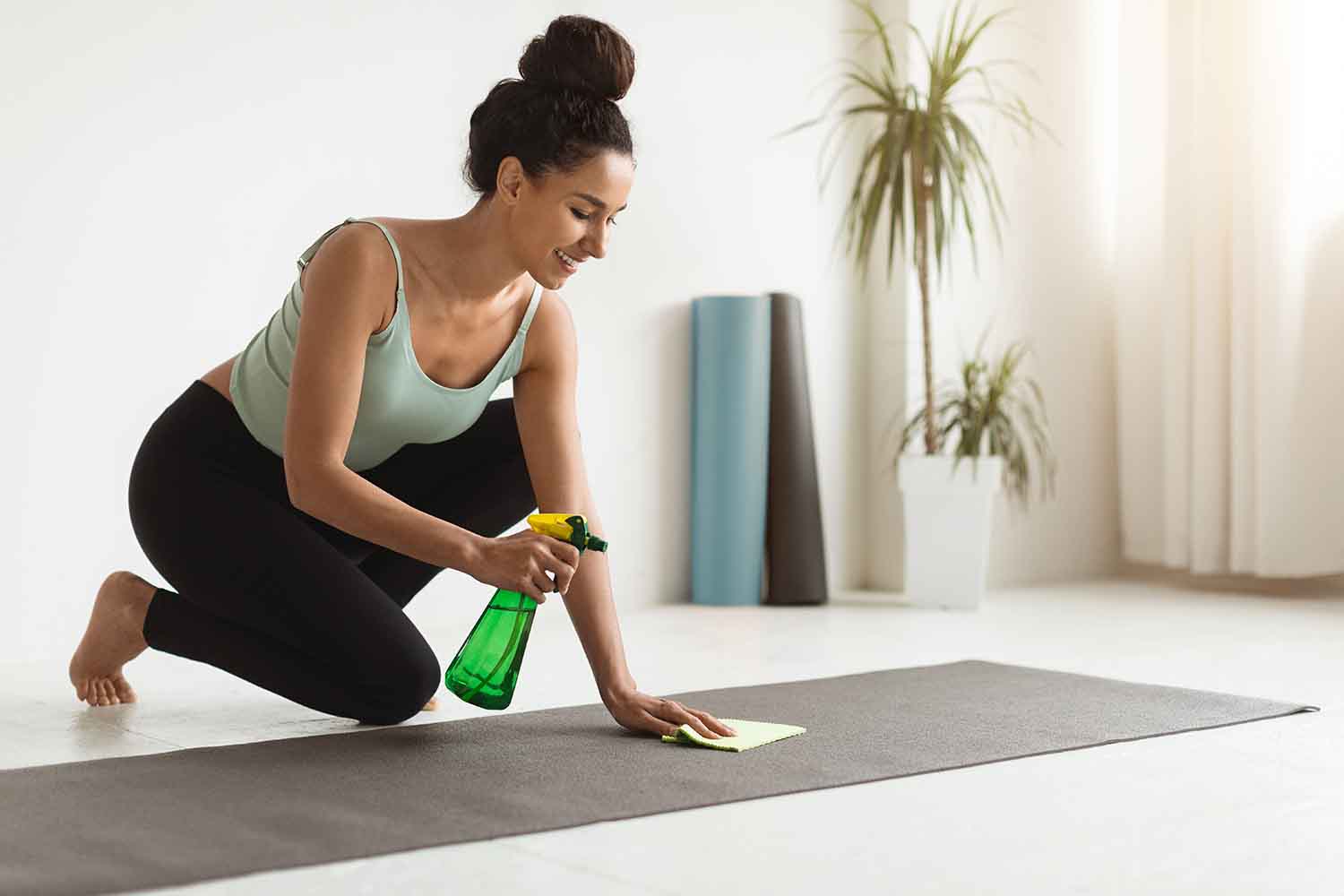Why It’s Important to Keep Your Yoga Mat Clean
Keeping your yoga mat clean is crucial for several reasons, particularly for advanced practitioners who demand both performance and hygiene. Regularly cleaning your mat helps maintain its grip and texture, which are essential for executing complex poses safely and effectively.
When mats accumulate sweat, dirt, and bacteria, they can become slippery, increasing the risk of injury during dynamic movements. Additionally, a dirty mat may harbor harmful microbes that can lead to skin irritations or infections, particularly for those who practice frequently. Therefore, ensuring cleanliness not only protects your health but also enhances your overall practice.
Key Benefits of a Clean Yoga Mat:
- Improved Grip: A clean surface allows for better traction, enabling you to hold challenging poses without slipping.
- Hygiene Maintenance: Regular cleaning prevents the buildup of bacteria, fungi, and unpleasant odors, creating a healthier practice environment.
- Extended Lifespan: Proper care can prolong the life of your mat, ensuring it remains supportive and functional for years to come.
Cleaning your mat after each use helps remove sweat and dirt, while a deeper cleaning routine every few weeks can eliminate any stubborn residues.
Transitioning to a fresh, clean surface fosters a positive mindset during your practice, allowing you to focus on alignment and breath instead of distraction from grime.
Ultimately, investing time in maintaining your yoga mat is an investment in your practice. With proper care, your mat will continue to support your journey, allowing you to explore new depths in your practice while prioritizing health and safety.
Risks of Not Cleaning Your Mat Properly
Neglecting proper cleaning of your yoga mat poses several significant risks that can impact both your health and your practice. First and foremost, bacteria and fungi can thrive in the warm, moist environment created by sweat and dirt on the mat’s surface. This microbial growth increases the likelihood of skin infections, rashes, and irritations, especially when practicing without proper hygiene.
In addition to health concerns, a dirty mat can compromise your performance. A buildup of sweat and grime can make the surface slippery, which may lead to slips and falls during complex poses. This lack of grip not only hinders your ability to maintain balance but also increases the risk of injury, especially for advanced practitioners who engage in more dynamic movements.
Another risk involves the mat’s longevity. Over time, neglecting regular cleaning can lead to material degradation, causing the mat to lose its supportive properties and structural integrity. This deterioration may result in an uneven surface that offers less cushioning and support, ultimately affecting your practice’s effectiveness.
Furthermore, a poorly maintained mat can harbor unpleasant odors, making your practice less enjoyable and potentially discouraging you from training regularly. The psychological impact of using a dirty mat can detract from your focus and connection to your practice, leading to a less fulfilling experience.
To mitigate these risks, establishing a consistent cleaning routine is essential. This practice not only protects your health and enhances performance but also preserves the quality of your yoga mat, ensuring it remains a reliable companion on your journey.
Step-by-Step Guide to Clean a Yoga Mat
Before you begin the cleaning process, it’s essential to gather all necessary materials to ensure a smooth and efficient experience. You will need a suitable cleaner specifically designed for yoga mats, which can effectively remove sweat and dirt without damaging the material. Additionally, have a soft cloth or microfiber towel on hand for wiping down the mat. A spray bottle filled with water can also be useful for diluting your cleaning solution if needed. Lastly, if you prefer a commercial option, a mat cleaner can provide convenience and effectiveness.
Once you have all your supplies, clear a space where the yoga mat can dry thoroughly. A well-ventilated area is ideal, as it helps prevent moisture buildup that could lead to mold or unpleasant odors. If possible, choose a shaded spot away from direct sunlight, which can cause the mat to warp or fade. Setting up a designated cleaning area ensures you can focus on the task without interruptions.

Simple Methods to Clean Your Yoga Mat
Begin the cleaning process by wiping down the surface of your yoga mat with your chosen cleaning solution. Lightly spray the solution across the mat, ensuring even coverage. Use a soft cloth to gently wipe the mat’s surface, applying slight pressure to lift away dirt and sweat. For deeper spots or stubborn areas, scrub lightly with the cloth and additional cleaning solution. It’s important to maintain a gentle touch to avoid damaging the material.
After you’ve thoroughly cleaned the mat, rinse it lightly with clean water. Be cautious not to soak the mat, as excess moisture can compromise its texture and integrity. Instead, use a damp cloth to wipe away any residual cleaning solution, ensuring the surface is clean and free of chemicals.
DIY Mat Cleaning Solutions
If you prefer a more natural approach, creating a simple homemade cleaner is an excellent option. Combine equal parts of water and white vinegar in a spray bottle for an effective and eco-friendly solution. Alternatively, you can mix a few drops of mild soap with water for gentle cleaning. This DIY method is not only cost-effective but also allows you to avoid harsh chemicals.
For those who prefer quick results, using a commercial yoga mat cleaner can simplify the cleaning process. These products are specifically formulated to provide deep cleaning while being gentle on the mat’s material. They often come in convenient spray bottles, making application easy and efficient. Whichever method you choose, keeping your yoga mat clean will ensure it remains a supportive and hygienic foundation for your practice.
Best Practices for Drying and Storing Your Mat
To ensure your yoga mat remains in optimal condition, implementing best practices for drying and storage is essential, especially for advanced practitioners who rely on its performance. After cleaning, always allow your mat to air dry completely. This step prevents moisture buildup, which can lead to mold and mildew, compromising both hygiene and durability.
Drying Tips:
- Place the mat in a well-ventilated area to facilitate quicker drying.
- Avoid direct sunlight, as excessive heat can warp the material and cause fading.
- If time is limited, using a fan can expedite the drying process without exposing the mat to harmful rays.
Once the mat is dry, focus on proper storage techniques to maintain its integrity. Rolling the mat loosely is preferable to folding, as folds can create creases that affect its flatness and support during practice. If your mat has a carrying strap or bag, utilize it for added protection during transport.
Storage Guidelines:
- Store the mat in a cool, dry location away from direct sunlight.
- Avoid placing heavy objects on top of the mat, as this can lead to permanent dents or distortions.
- Periodically check for signs of wear, such as peeling or cracking, to address any issues before they worsen.
By following these best practices for drying and storing your yoga mat, you ensure it retains its essential properties for a long time.
How Often Should You Clean Your Yoga Mat?
You should clean your yoga mat regularly to maintain hygiene and performance. For daily users or those practicing hot yoga, clean your mat after each session. If you practice less frequently, aim to clean it every one to two weeks. Establishing a consistent cleaning routine helps prevent bacteria buildup and ensures your mat remains in good condition.
Recommended Cleaning Products for Yoga Mats
Choosing the Right Cleaner for Your Mat
When selecting a cleaner for your yoga mat, it’s essential to use a product specifically designed for this purpose. A mat cleaner formulated for yoga mats ensures effective cleaning without damaging the material. These specialized cleaners are gentle yet powerful, effectively removing sweat and dirt while preserving the mat’s grip and texture. Additionally, avoid harsh chemicals such as bleach or alcohol, as they can erode the mat over time, leading to deterioration and loss of performance. Opting for safe and effective cleaning solutions will help extend the lifespan of your yoga mat, keeping it in excellent condition for your practice.
Natural Cleaning Solutions to Spark Your Routine
If you prefer a more eco-friendly approach, consider using DIY cleaning solutions. A simple mixture of vinegar and water provides an effective natural alternative that can disinfect while being gentle on your mat. Combine equal parts of both in a spray bottle for easy application. For added benefits, incorporate essential oils like tea tree oil, known for its antimicrobial properties. Not only does this add a refreshing scent, but it also helps maintain cleanliness without resorting to synthetic fragrances. Embracing these natural cleaning solutions allows you to keep your mat fresh and hygienic while aligning with a holistic practice.

